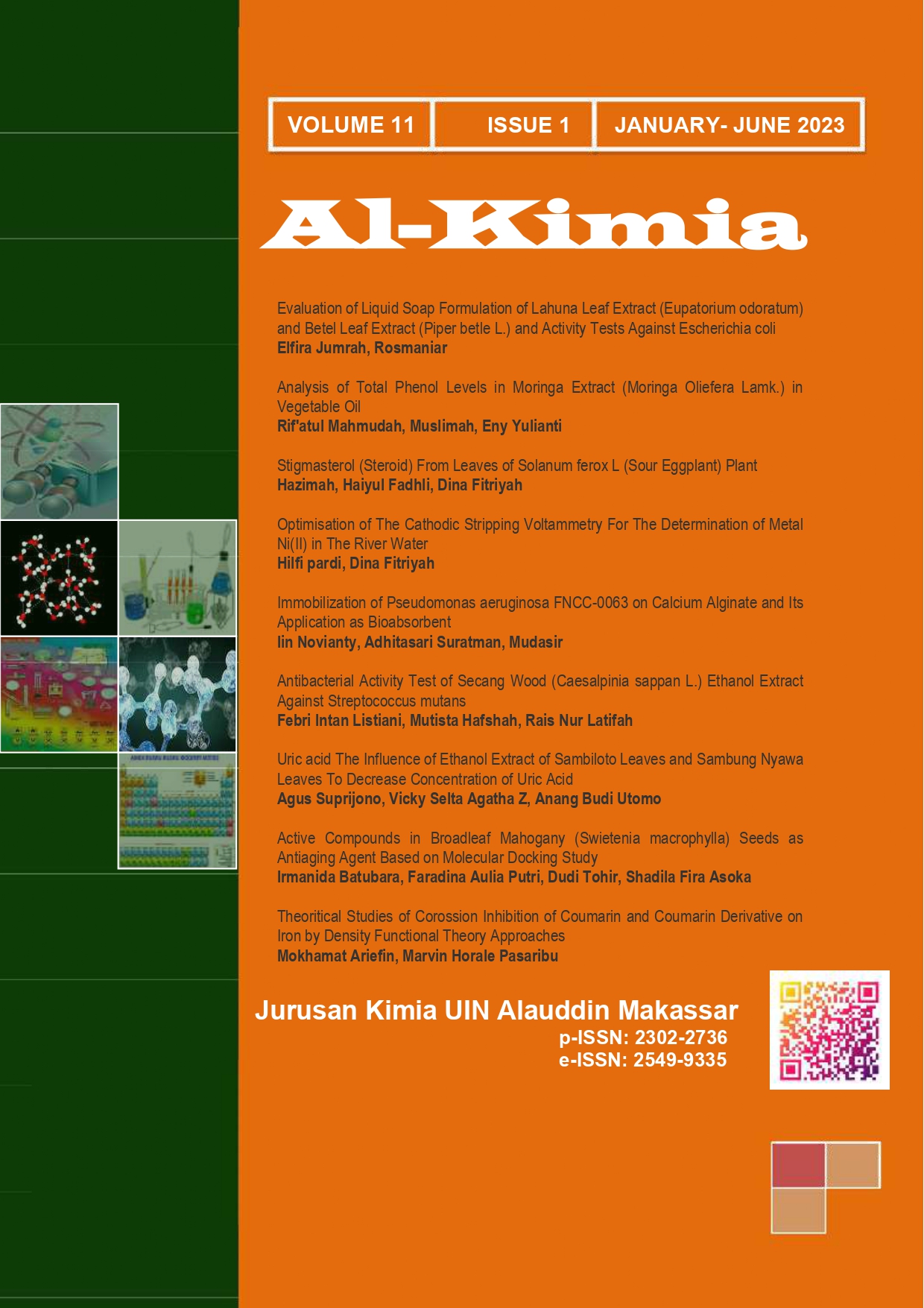Optimisation of The Cathodic Stripping Voltammetry For The Determination of Metal Ni(II) in The River Water
Abstract
The study was carried out to determination the metal Ni(II) in river water samples using cathodic stripping voltammetry (CSV) method. In order to achieve optimum conditions for the determination of metal Ni(II), the accumulation potential and accumulation time conditions of the CSV method have been achieved. The results of this research obtained under the optimum conditions for Ni(II) measurement using an electrolyte solution of ammonium chloride with a potential accumulation (accv) of -0.7 V and a time accumulation (acct) of 60 s. The relative standard deviation of the 10 µg/L Ni(II) standard solution (n=8) is 0.53%, the recovery value is 98.82%. The CSV method for the determination of Ni(II) metal has been successfully applied to river water samples.
Downloads
References
Afkhami, Abbas, Hamed Ghaedi, Tayyebeh Madrakian, and Majid Rezaeivala. 2013. “Highly Sensitive Simultaneous Electrochemical Determination of Trace Amounts of Pb(II) and Cd(II) Using a Carbon Paste Electrode Modified with Multi-Walled Carbon Nanotubes and a Newly Synthesized Schiff Base.” Electrochimica Acta 89: 377–86.
Batchelor-Mcauley, Christopher et al. 2015. “Recent Advances in Voltammetry.” ChemistryOpen 4(3): 224–60.
Cai, Jie et al. 2012. “Application of Bismuth-Film Modified Glassy Carbon Electrode for Solid-Phase Extraction of Sudan .” 3(2): 87–91.
Campisi, Sebastiano, Marco Schiavoni, Carine Edith Chan-Thaw, and Alberto Villa. 2016. “Untangling the Role of the Capping Agent in Nanocatalysis: Recent Advances and Perspectives.” Catalysts 6(12): 1–21.
Deswati, Deswati, Hilfi Pardi, Hamzar Suyani, and Izzati Rahmi. 2018. “Adsorptive Stripping Voltammetry for the Simultaneous Determination of Cd, Cu, Cr, and Pb in Water Samples Using Fluorexon: An Optimization Single Factor.” Analytical & Bioanalytical Electrochemistry 10(11): 1491–1505.
Deswati, Hamzar Suyani, Izzati Rahmi, and Hilfi Pardi. 2017. “Application of Central Composite Design Optimization Technique for Determination of Copper in Fruit and Vegetable Samples with Adsorptive Stripping Voltammetry in the Presence of Calcein.” Rasayan Journal of Chemistry 10(4): 1359–67.
Ensafi, Ali A, T Khayamian, and Shokooh S Khaloo. 2004. “Application of Adsorptive Cathodic Differential Pulse Stripping Method for Simultaneous Determination of Copper and Molybdenum Using Pyrogallol Red.” 505: 201–7.
Esteban, Miquel, Cristina Ariño, and José Manuel Díaz-cruz. 2003. “Metal Complexation by Electroanalytical Techniques : Hard- and Soft-Modelling Approaches.” 2(3): 359–73.
Guzsvány, Valéria et al. 2014. “Sensors and Actuators B : Chemical Antimony Nanoparticle-Multiwalled Carbon Nanotubes Composite Immobilized at Carbon Paste Electrode for Determination of Trace Heavy Metals.” 191: 320–25.
Ismail, Sharifah Norkhadijah Syed et al. 2018. “Heavy Metals in Soil of the Tropical Climate Bauxite Mining Area in Malaysia.” Journal of Physical Science 29: 7–14.
Khaled, Azza, Amal Hessein, Ahmed M. Abdel-Halim, and Fadia M. Morsy. 2014. “Distribution of Heavy Metals in Seaweeds Collected along Marsa-Matrouh Beaches, Egyptian Mediterranean Sea.” Egyptian Journal of Aquatic Research 40(4): 363–71. http://dx.doi.org/10.1016/j.ejar.2014.11.007.
Koropitan, Alan Frendy, and Muhammad Reza Cordova. 2017. “Study of Heavy Metal Distribution and Hydrodynamic Simulation in Green Mussel Culture Net, Cilincing Water - Jakarta Bay.” Makara Journal of Science 21(2): 89–96.
Lee, Jongmin, Soosung Kim, and Heungjoo Shin. 2021. “Hierarchical Porous Carbon Electrodes with Sponge-like Edge Structures for the Sensitive Electrochemical Detection of Heavy Metals.” Sensors (Switzerland) 21(4): 1–15.
Mohadesi, Alireza, Elham Teimoori, Mohammad Ali Taher, and Hadis Beitollah. 2011. “Adsorptive Stripping Voltammetric Determination of Cobalt ( II ) on the Carbon Paste Electrode.” 6: 301–8.
Morsi, M A et al. 2011. “Determination of Lead by Square Wave Adsorptive Stripping Voltammetery Using Ammonium Pyrrolidine Dithiocarbamate.” 7(6): 1173–79.
Nindyapuspa, Ayu, and Achmad Chusnun Ni’Am. 2018. “Distribution of Heavy Metals (Cu and Fe) in Sea Water of Gresik Coastal Area.” E3S Web of Conferences 31: 2017–19.
Pardi, H., Deswati, H. Suyani, and T.W. Edelwis. 2019. “Cathodic Stripping Voltammetric Determination of Essential Element (Copper and Zinc) in Drinking Water.” Analytical and Bioanalytical Electrochemistry 11(6).
Rahmi, Izzati et al. 2021. “Application of the Adsorptive Stripping Voltammetry-Response Surface Methodology (AdSV-RSM) in the Simultaneous Determination of Copper Ions in an Aquaponics System.” International Journal of Environmental Analytical Chemistry 00(00): 1–15. https://doi.org/10.1080/03067319.2021.1897981.
Raj, J, Anupuma Raina, and T D Dogra. 2013. “Direct Determination of Zinc , Cadmium , Lead , Copper Metal in Tap Water of Delhi ( India ) by Anodic Stripping Voltammetry Technique.” 09009: 3–6.
Vongdala, Noudeng et al. 2019. “Heavy Metal Accumulation in Water, Soil, and Plants of Municipal Solid Waste Landfill in Vientiane, Laos.” International Journal of Environmental Research and Public Health 16(1): 1–13.
Authors who publish with this journal agree to the following terms:
1) Authors retain copyright and grant the journal right of first publication with the work simultaneously licensed under a Creative Commons Attribution License that allows others to share the work with an acknowledgement of the work's authorship and initial publication in this journal.
2) Authors are able to enter into separate, additional contractual arrangements for the non-exclusive distribution of the journal's published version of the work (e.g., post it to an institutional repository or publish it in a book), with an acknowledgement of its initial publication in this journal.
3)Authors are permitted and encouraged to post their work online (e.g., in institutional repositories or on their website) prior to and during the submission process, as it can lead to productive exchanges, as well as earlier and greater citation of published work (See The Effect of Open Access).


